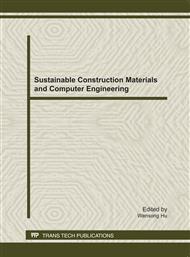[1]
M. Aiu, C. P. Huang: The chemistry and physics of nano-cement, research experience for under graduates in bridge engineering, University of Delaware, (2006).
Google Scholar
[2]
Li H., H. Xiao, J. Ou: A study on mechanical and pressure-sensitive properties of cement mortar with nanophase materials, Cement and Concrete Research Vol. 34, (2004), pp.435-438.
DOI: 10.1016/j.cemconres.2003.08.025
Google Scholar
[3]
Y. Qing, Z. Zenan, K. Deyu, C. Rongshen: Influence of nano-SiO2 addition on properties of hardened cement paste as compared with silica fume, Construction and Building Materials Vol. 21, (2007), pp.539-545.
DOI: 10.1016/j.conbuildmat.2005.09.001
Google Scholar
[4]
G. Li: Properties of high-volume fly ash concrete incorporating nano-SiO2, Cement and Concrete Research, Vol. 34, (2004), pp.1043-1049.
DOI: 10.1016/j.cemconres.2003.11.013
Google Scholar
[5]
D. F. Lin, K.L. Lin, W.C. Chang, H.L. Luo , M.Q. Cai: Improvements of nano-SiO2 on sludge/fly ash mortar. Waste Management, Vol. 28, (2008), p.1081–1087.
DOI: 10.1016/j.wasman.2007.03.023
Google Scholar
[6]
B. Jo, C. Kim., G. Tae, J. Park: Characteristics of cement mortar with nano-SiO2 particles, Construction and Building Materials, Vol. 21, (2007), pp.1351-1355.
DOI: 10.1016/j.conbuildmat.2005.12.020
Google Scholar
[7]
T. Ji: Preliminary study on the water permeability and microstructure of concrete incorporating nano-SiO2, Cement and Concrete Research, Vol. 35, (2005), p.1943-(1947).
DOI: 10.1016/j.cemconres.2005.07.004
Google Scholar
[8]
H. Li, H. Xiao, J. Yuan, J. Ou: Microstructure of cement mortar with nano-particles, Composite: part B, Vol. 35, (2004), pp.185-189.
DOI: 10.1016/s1359-8368(03)00052-0
Google Scholar
[9]
D.G. Nair, A Fraaij: Husk ashes, Cement and Concrete Research, Vol. 6, (2008), p.861–869.
Google Scholar
[10]
Sadrmomtazi , A .K. Haghi: Mechanical properties of cement based and composite containing rice husk ash, International journal of applied mechanic and engineering, Vol. 3, (2008).
Google Scholar
[11]
Q. Feng, H. Yamamichi, M. Shoya, S. Sugita: Study on the pozzolanic properties of rice husk ash by hydrochloric acid pretreatment, Cement and Concrete Research, Vol. 34, (2004), pp.521-526.
DOI: 10.1016/j.cemconres.2003.09.005
Google Scholar
[12]
R. Jauberthie, F. Rendell, S. Tamba, I. Cisse: Origin of the pozzolanic effect of rice husks, Construction and Building Materials, Vol. 14, (2000), pp.419-423.
DOI: 10.1016/s0950-0618(00)00045-3
Google Scholar
[13]
ASTM C-778, Standard specification for standard sand, Vol. 4. 01, pp.360-362. Annual book of ASTM standards (2000).
Google Scholar
[14]
ASTM C-109: Standard test method for compressive strength of hydraulic cement mortars, Vol. 4. 01, pp.84-89. Annual book of ASTM standards (2000).
Google Scholar
[15]
ASTM C-348: Standard test method for flexural strength of hydraulic cement mortar, Annual book of ASTM standards, Vol. 4. 01, 221-226, (2000).
Google Scholar
[16]
J. Kaufmann, F. Winnefeld, D. Hesselbarth: Effect of the addition of ultra fine cement and short fiber reinforcement on shrinkage rheological and mechanical properties of Portland cement pastes, Cement and Concrete Research, Vol. 26, (2004).
DOI: 10.1016/s0958-9465(03)00070-2
Google Scholar


